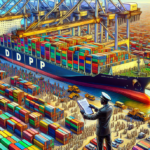Introduction to Incoterms in International Trade
In the realm of international trade, understanding Incoterms is essential for both buyers and sellers. Incoterms, short for International Commercial Terms, provide a standardized framework that defines the responsibilities and risks associated with the transportation of goods across borders. This clarity helps prevent misunderstandings, delays, and additional costs that can arise from differing interpretations of trade terms.
Understanding DAP and DDP Incoterms
What are DAP and DDP Incoterms?
DAP (Delivered at Place) and DDP (Delivered Duty Paid) are two widely used Incoterms that outline the division of responsibilities between buyers and sellers. While both terms involve the seller delivering goods to a specified location, they differ significantly in terms of customs duties and taxes.
Key Differences Between DAP and DDP
- DAP: The seller is responsible for delivering the goods to a designated location, such as a port or warehouse. However, the buyer handles import duties, taxes, and customs clearance.
- DDP: The seller assumes full responsibility, delivering the goods directly to the buyer’s premises and managing all aspects of customs clearance, including duties and taxes.
Advantages and Disadvantages
- DAP:
- Pros: Lower shipping costs as the buyer manages certain logistics; greater control over import processes.
- Cons: Increased responsibility and potential complexity for the buyer in handling customs and duties.
- DDP:
- Pros: Simplified process for the buyer with the seller handling all logistics and customs formalities.
- Cons: Higher costs for the seller and potential complications if customs regulations change.
Selecting the Right Incoterm for Your Business
Factors to Consider
Choosing between DAP and DDP depends on various factors:
- Nature of Goods: Perishable or high-value goods might benefit more from DDP to ensure timely and secure delivery.
- Market Expertise: Buyers with established relationships with local customs brokers may prefer DAP.
- Cost Management: Sellers needing to offer competitive pricing might opt for DAP to reduce their expenses.
Determining the Best Fit
Evaluate your company's capabilities, the specific needs of your customers, and the complexities of the target market's regulatory environment. Utilizing tools and resources can aid in making an informed decision.
Implementing DAP and DDP Incoterms in Your Business
Step-by-Step Implementation Guide
- Identify Business Needs: Assess your logistics capabilities and customer preferences.
- Choose the Appropriate Incoterm: Select DAP or DDP based on your assessment.
- Incorporate into Contracts: Clearly define the chosen Incoterm in all sales agreements.
- Train Your Team: Ensure that your logistics and sales teams understand their responsibilities under the chosen Incoterm.
- Partner with Reliable Logistics Providers: Collaborate with trusted carriers and customs brokers to facilitate smooth transactions.
- Monitor and Review: Continuously assess the effectiveness of the chosen Incoterm and make adjustments as necessary.
Best Practices and Avoiding Common Mistakes
Common Mistakes to Avoid
- Assuming Incoterms cover all aspects of the transaction, including insurance, without explicit agreement.
- Failing to clearly define the point of delivery and responsibilities in the contract.
- Overlooking the impact of local regulations and import/export laws.
Tips for Negotiating Optimal Terms
- Research Local Regulations: Understand the import requirements of the destination country.
- Communicate Clearly: Ensure all parties have a mutual understanding of their responsibilities.
- Build Strong Relationships: Establish trust with your trading partners to facilitate smoother negotiations.
- Seek Expert Advice: Consult with trade experts or legal advisors to navigate complex transactions.
Ensuring Compliance with International Trade Regulations
Key Compliance Strategies
- Stay Informed: Keep up-to-date with the latest trade regulations and Incoterm updates from the International Chamber of Commerce (ICC).
- Maintain Accurate Documentation: Ensure all shipping documents are complete and compliant with local laws.
- Utilize Professional Services: Engage customs brokers and legal advisors to handle complex compliance issues.
- Implement Robust Tracking Systems: Use technology to monitor shipments and promptly address any compliance issues.
Real-Life Examples and Case Studies
Successful Implementation of DAP and DDP
- Boeing: Utilizes DDP Incoterm for exporting aircraft, managing all logistics and ensuring timely delivery to clients globally.
- L'Oreal: Applies DAP Incoterm when importing cosmetics from Asia, allowing greater control over local logistics and customs processes.
The Future of Incoterms
The International Chamber of Commerce (ICC) reviews and updates Incoterms every ten years to reflect evolving global trade dynamics. The latest update in 2020 introduced changes to several terms, including DPU (Delivered at Place Unloaded). Future revisions are expected to address advancements in technology, sustainability practices, and shifts in global trade patterns. Businesses should stay informed about these changes to maintain compliance and optimize their international trade strategies.
Conclusion: Mastering Incoterms for International Trade Success
Mastering Incoterms is pivotal for navigating the complexities of international trade. By understanding the nuances of DAP and DDP, businesses can streamline their logistics, mitigate risks, and enhance their global competitiveness. Implementing the right Incoterm, adhering to compliance standards, and learning from real-life case studies will equip your business for sustained success in the international marketplace.






















